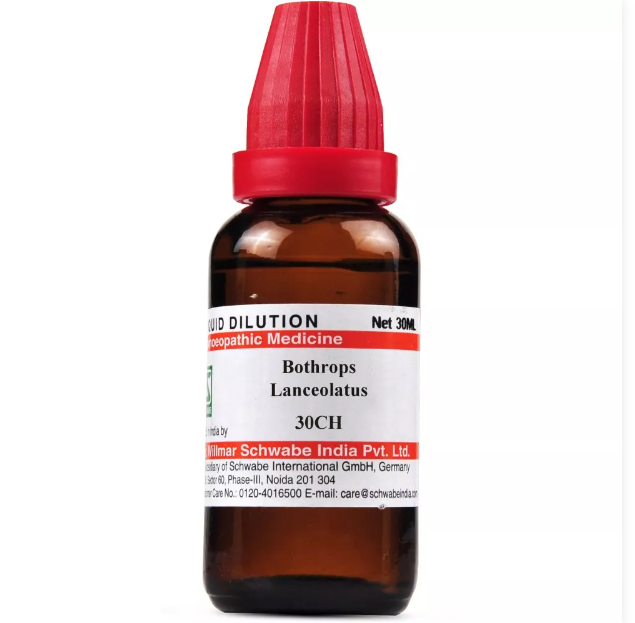BOTHROPS LANCIOLATUS 6C, 12C, 30C, 200C, 1M, 10M USES AND SYMPTOMS
 Bothrops lanciolatus, also known as the Yellow Viper, exhibits a venom with remarkable coagulating properties, akin to Lachesis. Symptoms include thrombotic phenomena such as hemiplegia, aphasia, and inability to articulate, as observed by Linn J. Boyd. This remedy is indicated for hemorrhagic constitutions and septic states, characterized by great lassitude, sluggishness, and hemorrhages from various bodily orifices, often accompanied by black spots. Hemiplegia with aphasia and nervous trembling are notable presentations. Additionally, symptoms may manifest diagonally across the body. Pulmonary congestion is also observed.
Bothrops lanciolatus, also known as the Yellow Viper, exhibits a venom with remarkable coagulating properties, akin to Lachesis. Symptoms include thrombotic phenomena such as hemiplegia, aphasia, and inability to articulate, as observed by Linn J. Boyd. This remedy is indicated for hemorrhagic constitutions and septic states, characterized by great lassitude, sluggishness, and hemorrhages from various bodily orifices, often accompanied by black spots. Hemiplegia with aphasia and nervous trembling are notable presentations. Additionally, symptoms may manifest diagonally across the body. Pulmonary congestion is also observed.
Eyes: Amaurosis; blindness from hemorrhage into the retina, Hemeralopia (day blindness), difficulty seeing after sunrise; conjunctival hemorrhage.
Face: Swollen and puffy; besotted expression.
Throat: Red, dry, constricted; dysphagia, difficulty swallowing liquids.
Stomach: Epigastric distress; black vomiting; intense hematemesis; tympanitis and bloody stools.
Skin: Swollen, livid, cold with hemorrhagic infiltration; gangrene; swollen lymphatics; anthrax; malignant erysipelas.
Modalities: Symptoms worse on the right side of the body.
Relationship: Similar remedies include Toxicophis pugnax (Moccasin snake) and Trachinus draso (Stingfish). Toxicophis pugnax is known for recurring pain and fever following a bite, with symptoms changing location. Dryness of the skin may follow the bite, along with edematous swellings and periodical neuralgia. Pain can shift from one part of the body to another. Trachinus draso causes intolerable pains, swelling, acute blood poisoning, and gangrene.
Dosage: Sixth to thirtieth potency.
SYMPTOMS OF BOTHROPS LANCIOLATUS LACHESIS LANCIOLATUS
Eyes:
Amaurosis
Blindness from hemorrhage into the retina
Hemeralopia (day blindness)
Can hardly see her way after sunrise
Conjunctival hemorrhage
Face:
Swollen and puffy
Besotted expression
Throat:
Red, dry, constricted
Dysphagia, cannot pass liquids
Stomach:
Epigastric distress
Black vomiting
Intense hematemesis
Tympanitis
Bloody stools
Skin:
Swollen, livid, cold with hemorrhagic infiltration
Gangrene
Lymphatics swollen
Anthrax
Malignant erysipelas
Modalities:
Worse on the right side
Relationship:
Compare to Toxicophis pugnax (Moccasin snake) and other snake poisons like Lachesis. Also, Trachinus draso (Stingfish) due to intolerable pains, swelling, acute blood poisoning, and potential gangrene.
selection of the potency
Individualization:
- Homeopathy is based on the principle of treating the individual, not just the disease. The unique symptoms and characteristics of the person are crucial in determining the most suitable potency.
Intensity of Symptoms:
- The intensity of the symptoms guides the choice of potency. If the symptoms are intense and acute, a lower potency (e.g., 6C, 30C) might be considered. For chronic conditions with less intensity, higher potencies (e.g., 200C, 1M) may be appropriate.
Sensitivity of the Patient:
- Some individuals are more sensitive to homeopathic remedies, while others may require higher potencies. The practitioner considers the patient’s sensitivity when selecting the potency.
Acute vs. Chronic Conditions:
- Lower potencies are often used for acute conditions, while higher potencies may be considered for chronic or long-standing issues.
Previous Response to Potencies:
- The patient’s response to previous homeopathic treatments helps guide the choice of potency. If a particular potency has been effective in the past, it may be repeated or adjusted as needed.
Vital Force and Susceptibility:
- Homeopathy views illness as a disturbance in the vital force. The practitioner assesses the patient’s overall vitality and susceptibility to determine the appropriate potency.
Aggravation or Amelioration:
- The direction of the symptom response (aggravation or amelioration) after taking a remedy can influence the choice of potency.
Miasmatic Considerations:
- In classical homeopathy, the concept of miasms (inherited disease tendencies) is considered. The practitioner take this into account when selecting the potency.
Practitioner Experience:
- The experience and preference of the homeopathic practitioner play a role. Some practitioners may have success with certain potencies based on their clinical experience.
SAFETY INFORMATION
- Do not exceed the recommended dose by physician
- Keep out of the reach of children
- Store in a cool dry place away from direct sunlight
- Maintain half an hour gap between food/drink/any other medicines and homoeopathic medicine
- Avoid any strong smell in the mouth while taking medicine e.g. camphor, garlic, onion, coffee, hing
Medicine images use for reference only selection of homeopathic medicine depends on the individual’s specific symptoms and overall constitution. Moreover, homeopathy is a holistic system of medicine that treats the individual as a whole. In addition to addressing the physical symptoms, it takes into account the emotional and mental state of the person. Consequently, it’s crucial to consult with a qualified homeopathic practitioner for personalized treatment.
The information provided on this website is intended solely for educational purposes. Always seek the advice of your physician or other qualified health provider.
